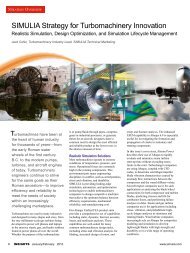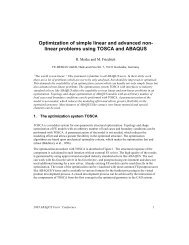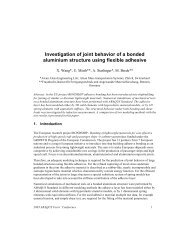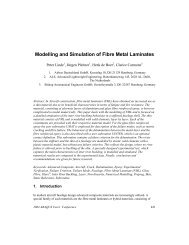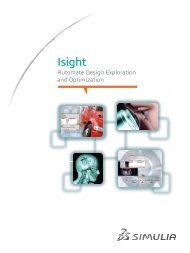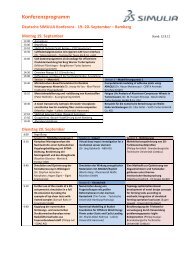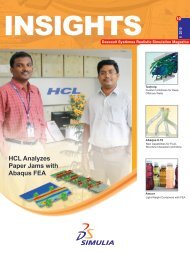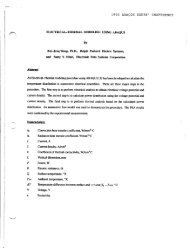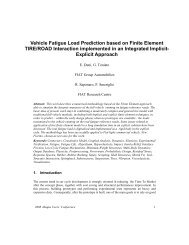CZone for Abaqus - Simulia
CZone for Abaqus - Simulia
CZone for Abaqus - Simulia
You also want an ePaper? Increase the reach of your titles
YUMPU automatically turns print PDFs into web optimized ePapers that Google loves.
<strong>CZone</strong> <strong>for</strong> <strong>Abaqus</strong><br />
Advanced crush simulation <strong>for</strong> energy-absorbing structures<br />
made from laminated composites<br />
Overview<br />
Crushable structures that absorb energy during impact are used in automobiles,<br />
helicopters, aircraft, trains, and other transport vehicles to help protect occupants and<br />
cargo from shock and injury during a crash. Composite materials hold great potential <strong>for</strong><br />
providing increased energy absorption in lower-weight crushable structures as compared<br />
to conventional heavier metallic designs. A lack of commercial, industry-standard<br />
methods to simulate and accurately predict the crushing of these materials during impact<br />
has impeded the widespread application of composite materials in crushable structures.<br />
<strong>CZone</strong> <strong>for</strong> <strong>Abaqus</strong> is a new add-on capability to <strong>Abaqus</strong>/Explicit that provides access to<br />
a state-of-the-art methodology <strong>for</strong> crush simulation. Based on <strong>CZone</strong> technology from<br />
Engenuity Ltd., and targeted toward the design of composite components and assemblies<br />
in the Automotive and Aerospace industries, <strong>CZone</strong> <strong>for</strong> <strong>Abaqus</strong> provides <strong>for</strong> inclusion of<br />
material crush behavior in FEA simulations of composite structures subjected to impact.<br />
SIMULIA<br />
A mass of 1150 kg. moving at an initial velocity of 9.1 m/s impacts a complex composite cone structure in an experimental sled test. Crushing of the cone<br />
progresses to a point where a large fracture develops suddenly in the transition region between the cone and its backup structure. <strong>CZone</strong> <strong>for</strong> <strong>Abaqus</strong><br />
results predict well both the crushing response and the sudden fracture outside the crush front. Acceleration histories of the sled mass correlate well<br />
when comparing experimental data (blue) against simulation results (green).
SIM-<strong>CZone</strong>-0708<br />
<strong>CZone</strong> <strong>for</strong> <strong>Abaqus</strong><br />
Features & Benefits<br />
<strong>CZone</strong> technology provides direct implementation of crushbased<br />
element <strong>for</strong>ce generation and failure in defined “crush<br />
zones,” typically located at the <strong>for</strong>ward edges of the structure in<br />
direct contact with the impactor. <strong>CZone</strong> <strong>for</strong> <strong>Abaqus</strong> simulations<br />
determine the extent of material crushing and other modes<br />
of composite failure, the energy absorbed in the crush zone,<br />
and the <strong>for</strong>ces generated by material crushing. The behavior<br />
of the composite structure outside the crush zone is simulated<br />
utilizing existing <strong>Abaqus</strong> capabilities to account <strong>for</strong> possible<br />
delamination, damage, fracture, and buckling.<br />
With <strong>CZone</strong> <strong>for</strong> <strong>Abaqus</strong> results as a guide, a proposed<br />
design can be altered to optimize the placement, thickness,<br />
construction, and geometry of crush structures to maximize their<br />
energy-absorbing capacity.<br />
Crush properties <strong>for</strong> candidate materials can be obtained in<br />
a cost-effective manner from coupons cut from flat panel<br />
specimens. Such crush testing and calibration services are<br />
available directly from Engenuity; other test laboratories are<br />
also developing this capability. This in<strong>for</strong>mation can also help<br />
in screening and selecting appropriate materials to use in a<br />
structure and evaluate whether candidate materials behave well<br />
or poorly during crushing.<br />
SIMULIA<br />
166 Valley Street<br />
Providence, RI 02909 USA<br />
+1 401 276 4400<br />
E-mail: simulia.info@3ds.com<br />
The 3DS logo, CATIA, ENOVIA, SIMULIA, <strong>Abaqus</strong>, and Unified FEA<br />
are trademarks or registered trademarks of Dassault Systèmes or its<br />
subsidiaries. Other company, product, and service names may be trademarks<br />
or service marks of their respective owners.<br />
Copyright Dassault Systèmes, 2008<br />
SIMULIA Europe<br />
+31 43 356 6906<br />
E-mail: simulia.europe.info@3ds.com<br />
SIMULIA<br />
Crash Simulation with <strong>Abaqus</strong><br />
As a foundation <strong>for</strong> supporting the <strong>CZone</strong> technology, <strong>Abaqus</strong><br />
provides extensive capabilities to address crashworthiness and<br />
occupant safety simulation <strong>for</strong> the Automotive and Aerospace<br />
industries. This has been an ongoing strategic focus <strong>for</strong> several<br />
years, and <strong>Abaqus</strong> has been adopted as the primary tool <strong>for</strong> such<br />
design simulation at the OEM level.<br />
<strong>CZone</strong> <strong>for</strong> <strong>Abaqus</strong> represents the next step in extending crash<br />
simulation capabilities with <strong>Abaqus</strong> to include the prediction<br />
of the crushing behavior of composite structures. It also<br />
complements existing <strong>Abaqus</strong> capabilities <strong>for</strong> composite failure<br />
analysis, including damage mechanics <strong>for</strong> material degradation<br />
and failure, VCCT <strong>for</strong> brittle delamination, cohesive element<br />
technology <strong>for</strong> failure in adhesively bonded regions, and<br />
specialized woven composite material models.<br />
For More In<strong>for</strong>mation<br />
To learn how <strong>CZone</strong> <strong>for</strong> <strong>Abaqus</strong> can add value to your composite<br />
design processes, contact your local SIMULIA office. Contact<br />
in<strong>for</strong>mation <strong>for</strong> all SIMULIA offices can be found by visiting<br />
www.simulia.com or by calling +1 (401) 276-4400.<br />
Crushing of a composite cone structure with a rigid insert bonded into a cutout in the cone is simulated in <strong>CZone</strong> <strong>for</strong><br />
<strong>Abaqus</strong>. As the impactor reaches the bonded insert, a fragment including the insert and portion of the cone breaks away<br />
from the structure, comparing well against a similar fragment that is produced in the experimental test.<br />
The composite front wing <strong>for</strong> an F1 race car is impacted against a rigid pole. Progressive crushing of the wing occurs as the<br />
pole penetrates through the wing. Significant <strong>for</strong>ces are also transferred through the structure, causing the wing to then break<br />
away from the vehicle.<br />
SIMULIA Japan<br />
+81 3 5474 5817<br />
E-mail: simulia.japan.info@3ds.com





